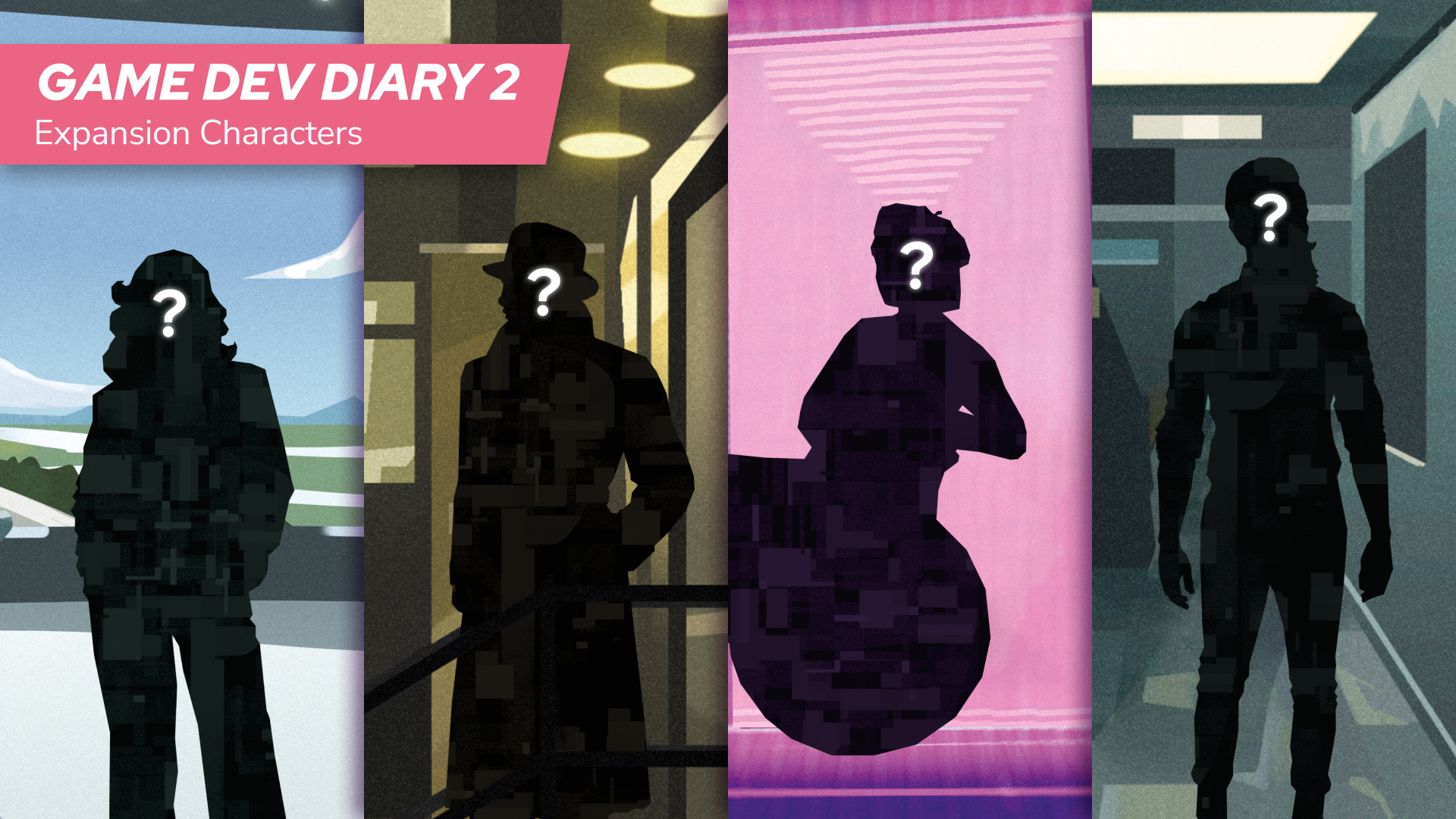Today’s update is in two parts. First Dominik will give you a quick overview of the general design intentions behind the “A Hopeful Cause” expansion and what content you can expect. Afterwards Richi Anna will give you a first look at the four new playable characters. Let’s go!
(Note: All cards shown in this article are still in playtesting and might receive changes. All art shown is placeholder and will be replaced for the final game. Your pledge enables us to commission real artists to make a 100% AI-free game.)

Hey folks!
I’m Dominik, the Lead Narrative Designer at Hopeful Games. Today I want to share some thoughts on how Francesco and I designed the first expansion for NEON HOPE.
Why Launch with an Expansion?
One thing we knew pretty early from our experience with similar games: If we wanted to offer character customization (or deck building), we needed to give players enough cards to provide meaningful choices. Though we also knew that this would be very hard to achieve within the limits of a Base Game.
There is an upper limit of how many cards we can add, before the Base Game becomes too expensive. We also could not take away cards from the campaign, as we did not want to compromise the story or replayability.
So an expansion with more characters was the only way to provide both: a self-contained Base Game with a full story campaign – and an established card pool, offering veteran card gamers enough variety to explore.
Our character system revolves around eight primary traits. Meaning, each Character has only access to the cards that share one of their two traits. An example would be Felina, who is an [Influencer] and [Insider]. With the expansion, we are adding four characters to offer a new combination of these eight traits. The newly introduced Matthéo M’Baye is an [Insider] and [Analyst]. This gives him the ability to not only Analyze encounter cards, as featured in Felina, but also the ability to Analyze modifiers as seen in Deniz. (Both abilities return with a new twist, but Anna will tell you more about this below.)
What’s more? More Replayability!
There were a lot of ideas for the first expansion. But after a quick discussion we quickly landed on one key design goal: We wanted this expansion to add as much replayability to the game as possible.
Four new characters were a good start to provide replayability, but that was not enough for us. We also wanted to make the Base Game something you could enjoy for at least 10+ playthroughs, always discovering something new on your next run. In the end we landed on two additional features:
Alternative Encounter Cards:
During testing we saw that changing encounter cards was the most impactful way to change the flow and feel of an episode – and to add new and unexpected challenges. Therefore, we are adding new encounter sets that can be used to replace the existing ones. Every episode in the Base Game will have at least two encounter sets that can be replaced.
The Nemesis Set:
The Nemesis set is actually an idea that came from two of our primary playtesters: Christopher and Malte. They had voiced two requests:
- After playing NEON HOPE for literally hundreds of hours, they felt that the challenge of the game was not “spicy” enough, even if they played on the highest difficulty.
- They were looking for more storytelling moments that are unique to their playthrough.
Both of these topics are addressed by the Nemesis set. It is a set of 10 encounter cards that represent unique foes and challenges. When starting a campaign you can draw one (or more) of those cards at random and it becomes your Nemesis. Your Nemesis will follow you through the whole campaign, replacing one of the regular difficulty cards in the encounter deck. Many of the Nemesis cards are especially designed to force you to adapt your strategies or character builds. Let me show two examples:

The Berlin Firewall forces you to rethink your approach to the support mechanic. How valuable is it to collect Attribute Markers or Hope, if this State will turn them off in a crucial situation? This will also have an impact on what cards you upgrade. As Get Support actions just get less valuable with the Berlin Firewall looming to come out at some point in every episode.
Pushing the Goal Post can be really rough. It forces you to overcommit on each and every action you do. So suddenly cards that reward you for over-succeeding or which have a lot of Impacts (but no attribute bonus) get worse. So over a campaign it becomes more valuable to invest in cards that get high attribute bonuses when leveled up.
The Nemesis set also introduces one difficulty even harder than the “Hopeless” difficulty, where you are challenged to add as many Nemesis cards as you dare!😀
Meet the Characters from the Expansion
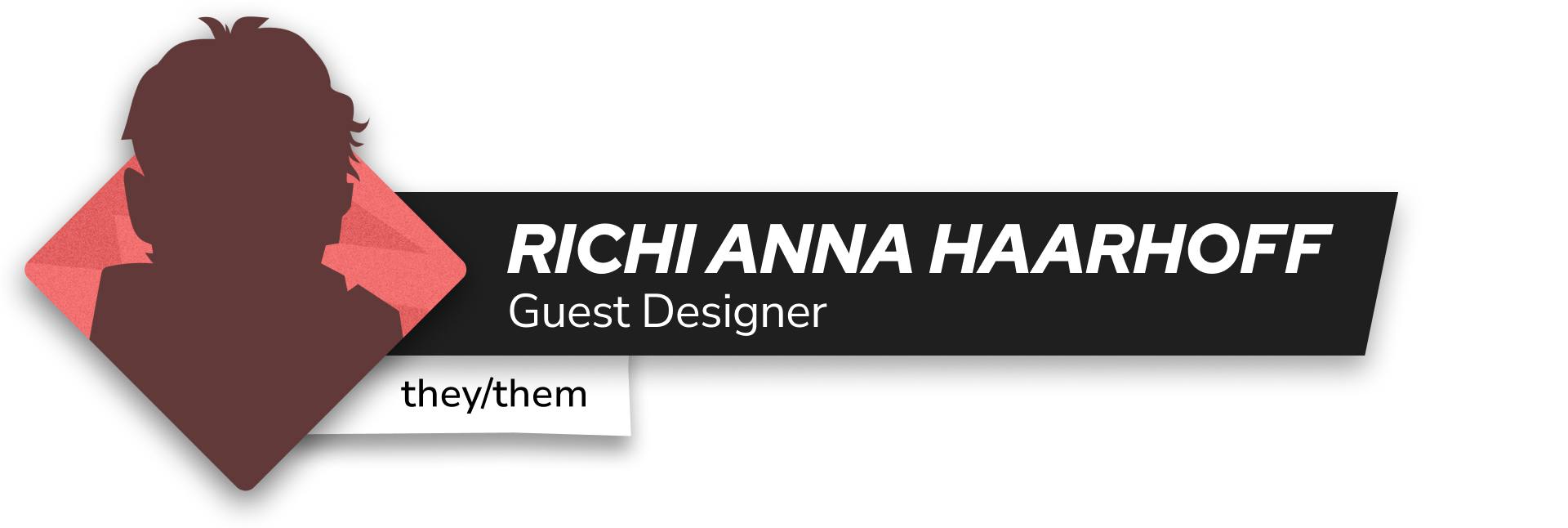
Hi everyone!
I’m Richi Anna, and I’m the Lead Designer of the four additional characters for the “A Hopeful Cause” expansion. Today, we’re giving you a sneak preview of those characters.
The characters from the Base Game establish a baseline for what the mechanics of NEON HOPE are and how they work. They were also designed with the intention to represent known archetypes and to give players an easy entrance into the game. By necessity, this means their strategies and mechanics have to be fairly straightforward. They also can’t be too specialized, so that no matter which combination of characters you pick, you’ll have a great time with your first campaign playthrough.
The expansion characters give us a chance to go a bit more “wild” and show off the full width and depth of the design space. We can create characters built around more niche game mechanics (Giulia Caparelli), or use established mechanics in new and exciting ways (Matthéo M’Baye). We can also break the established pattern of what Character Tools and stat lines are “supposed” to look like (Veeron5), or create a character that breaks playstyle expectations (Jan-Peter Grunwald).
When designing these characters, Dominik and Francesco provided me with the character’s names and backstories, and a very rough idea for their mechanics, but otherwise gave me almost completely free reign. The result is four characters that (by their own admission) Dominik and Francesco never would have designed that way themselves, but still fit nicely into the wonderful game that they’ve created.
But enough introduction. Let’s get started!
Matthéo M’Baye
Matthéo is a young black Frenchman, pushed by his middle-class family into a government job. As a welfare review specialist his job is to investigate social security fraud. A well paid job with a solid pension. But Matthéo has long had doubts about his career. Instead of helping to keep an overburdened social system running, he was just making it worse for those already struggling. Maybe it was time to turn the tables and investigate those in power instead?
Matthéo presented an interesting design challenge: As an [Analyst] and [Insider] character, he has access to effects that Analyze modifiers and encounter cards, so leaning into that was an easy choice. But I did not just want to give him more cards that simply give him an Analyze effect as a reward for succeeding at a task. So, I came up with alternate uses for the Analyze keyword, allowing him to use those effects as an integral part of his action, rather than “just” a side effect.
As another sub-theme of his character, he has cards that make his actions stronger depending on when during his turn he uses them. I’m a huge Columbo fan, so having an action card called “Just One More Thing”, that gets stronger when it’s the last thing you do on your turn, was an idea that I had very early in the design process. I’m glad I was able to find a place for it in Matthéo.
Giulia Caparelli
Giulia is an older Italian woman, who spent her life as a digital rights lawyer. She has witnessed the erosion of the right to digital self-determination in the last decades. Her fight for the public had never come with a lavish expense report – but she always felt good, when she won a case for the foundation she worked at. Though she had never expected to one day collect the evidence herself.
Like all expansion characters, Giulia is much more specialized, or “gimmicky”, than any of the base game characters. In her case, the gimmick revolves around the Retreat mechanic: She has an easier time retreating enemies and states, and gets bonuses for doing so. She also has some unique ways of supporting other players that bend the rules of what the game normally allows. (She is a lawyer, after all!)
Giulia was the first character I started designing, and she took a surprising amount of time to get right! With specialized characters like this, it’s always a challenge to make their mechanics feel impactful enough without making them overpowered, and to preserve their strong mechanical identity without making them too situational. But when you pull it off (and I’m confident to say that we did), you get a truly unique character!
Veeron5 (Veronika Ono)
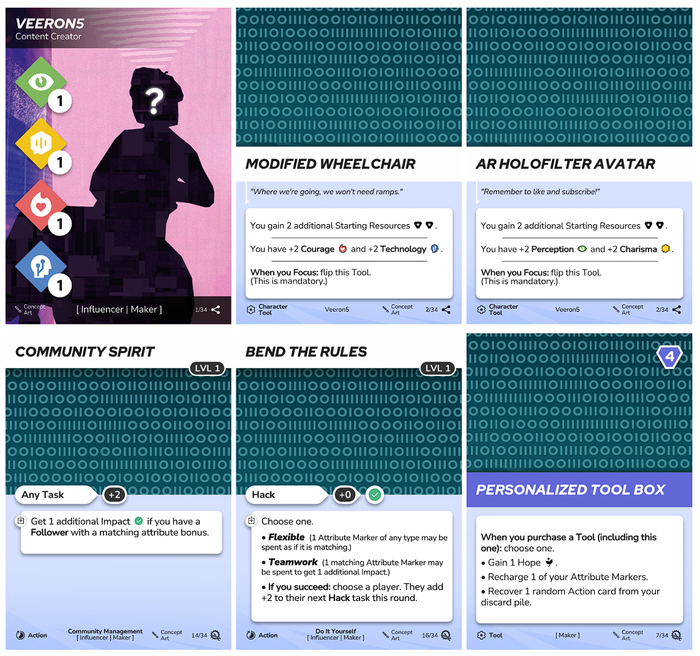
Veronika was always hanging around her mother’s small shop. Her single mother barely made enough by repairing electronics, giving them a new life. Veronika soldered her first microchip before she was seven. And built her first robot, when she was 12. She loved showing the things she built to the world. So at 16 she started her own channel, making streams about repairing gadgets and how to make your own. She had learned from her mother that everything can be rebuilt, machines, relationships and maybe even society.
We settled on the core mechanical idea of Veeron5 (her unique stat block and character tool) very early, but experimented with a few different versions of when and how she changes her stats. Ultimately, we settled on the version you see above, where you are not only allowed, but required to flip her character tool whenever you focus. This creates an interesting restriction to play around, but rewards players who master the timing of when to focus.
Veeron5 is a character who starts out quite weak, but builds up momentum faster and stronger than anyone else. Once you start collecting Attribute markers, Tools, and Followers, her cards are some of the strongest and most flexible cards in the game!
Jan-Peter Grunwald
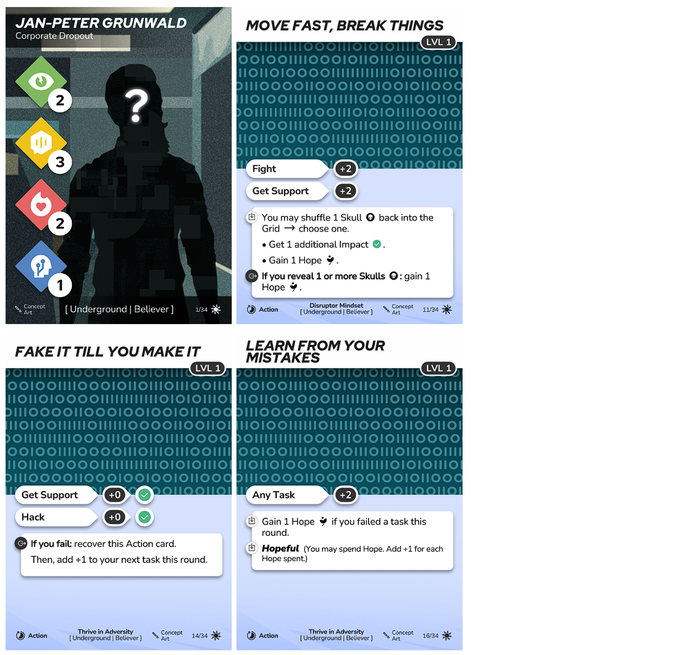
As a young man, Jan-Peter was part of the Havelland tech boom. He was a product manager and working on financial technologies promising a better future. But the crash came: His colleagues lost their jobs, his boss went to prison, and his boss’s bosses just got richer. Looking for redemption he dropped out. Now he lives down the river, where community is more valued than shareholder value. Here he sits outside his trailer working on his anarcho-futuristic manifesto.
Jan-Peter Grunwald was a lot of fun to design. My favorite character from the core game is Larx, whose high risk, high reward playstyle I find very appealing. Jan-Peter allowed me to create a character that leans even further into that kind of playstyle. If you prefer playing it safe, this is not the character for you. Jan-Peter’s cards reward you for attempting tasks even when you are likely to fail, or shuffle revealed skull modifiers back into the grid in exchange for extra impact. And when the gamble does not pay off, he fails forward, shrugging off the consequences and collecting extra Hope and other bonuses along the way.
Jan-Peter Grunwald was also a lot of fun to design from a thematic standpoint. He takes a lot of the worst impulses of corporate culture and throws them back in the megacorps’ faces. I always like to picture him yelling “Move fast, break things!” as he punches a security guard or throws a brick through a window.
What’s next?
We hope this gives you a good insight into what is included in the “A Hopeful Cause” expansion. And how our goal was to extend the Base Game in the most meaningful way possible for fans of strategic card games – which we include ourselves in.
We would love to hear which expansion character you are most excited for?
If you have any questions or want to know more about a specific character:
Let us know in the comments!
Stay hopeful!💚🙏
Dominik & Richi Anna

